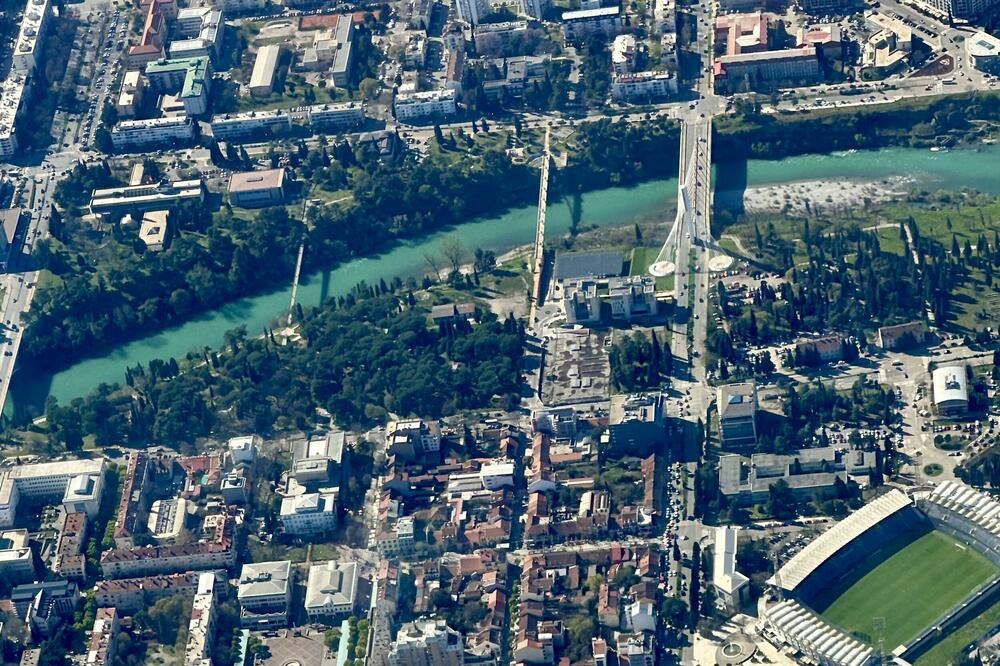The plane hovered above the snowy peaks. A little lower, you can see the paths carved into the stone and vegetation. Here, in the Montenegrin hills, man seemed to want to settle as close to heaven as possible. If this mountain solitude, this harsh opulence, were to be ironed out, Montenegro would occupy half of the Adriatic.
There is no time for geomelancholy, the plane is already maneuvering over Lake Skadar. Sunlight is scattered on it in all directions to gather again in the eye of the observer. The window of the plane tilts down and I recognize my destination below - Podgorica.
Most Milenijum, Morača, a tangle of streets. Then everything goes quickly, the plane hovers over the runway. Nearby I see a small church and a cemetery, a row of cypress trees. The horizon is jagged with white mountain spikes. The impact of the wheels on the runway was accompanied by the thought - I am in Montenegro again.
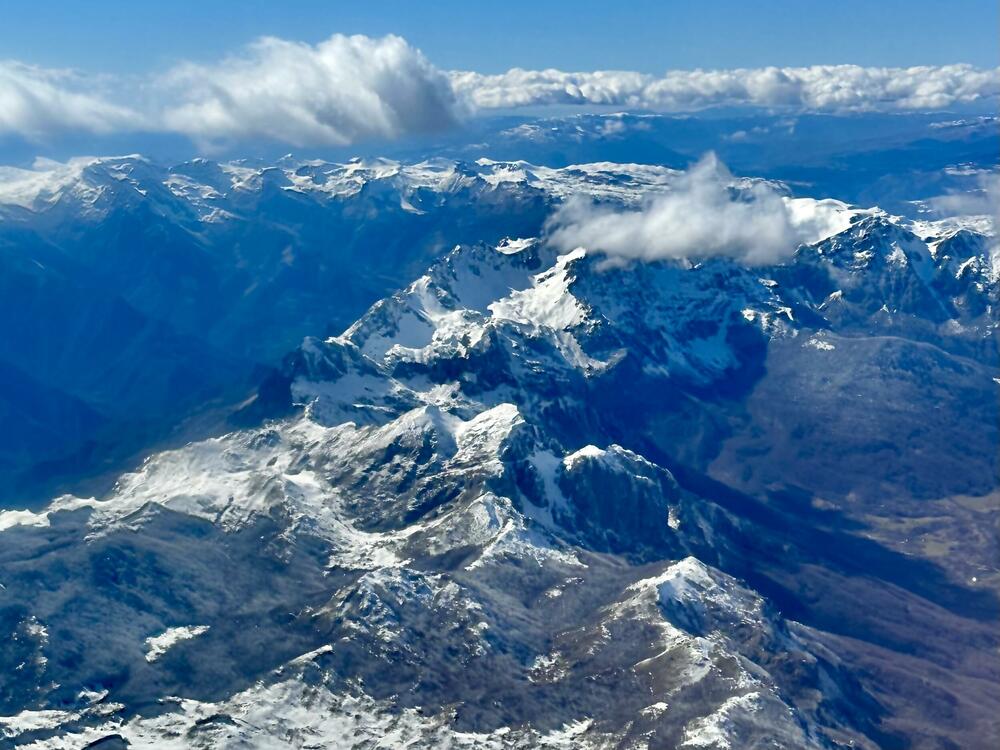
The taxi driver tells me about the high prices, taxes, inconsistency of politicians, corruption. So about the standard ailments of post-Yugoslav societies. He hoped that the new government would deal more harshly with crime. And that they will arrest at least those whom everyone knows are serious thieves.
We don't have time to ask who they are that everyone knows everything about, because his phone is ringing. I realize he's talking to a woman. When he finishes the conversation, he says with a slightly bitter smile: "He loves me the most when I get paid." And that is today. He can't wait to see me."
A bang without a bang
We arrive in front of the Hilton Hotel. It will take time for me to understand that it is like the top layer of a manuscript in a palimpsest, inscribed across the face of the Hotel Crna Gora, where I spent the night once back in the eighties. The glass garden, which replaced the former stone garden, looks impressive at first glance.
I was invited here to the round table "Montenegro as an eternal inspiration". It is organized by the Directorate for Cooperation with Diaspora-Expatriates, and the man in charge of all that, Zoran Đukanović, included me in the circle of participants on the recommendation of my long-time friend from Sarajevo, the writer Faiz Softić, who lives between Luxembourg, Sarajevo and his native Bihor.

I rarely have the opportunity to stay in hotels of this category. My habits are more modest. In the choice of venue for the meeting and in the level of organization, I see a sign that perhaps official Montenegro really cares about people who are connected to this country in one way or another, but until now, after the Yugoslav explosion, traveled the world as invisible shrapnel, under the radar , beyond the preferred narrative.
The rally did not start until tomorrow. I decided to dedicate the whole afternoon and evening to Podgorica, a city I have stayed in several times, without writing anything about it. First, hunger led me to a kebab shop specializing in the production of shish kebabs. I found out that the Podgorica version of this dish lost the stick on which the meat is skewered - the shish - in the transition, so it's actually an elongated patty that only by name refers to the original recipe, which implies meat on a skewer. The taste of shish kebab without shish was good.
Monuments as scars
Coincidentally, my walk started in Karađorđev Park. I've never been there, so the monument surprised me - with its similarity to the monument in front of the Temple in Belgrade. I would bet it was the work of the same hands. I sit down on the bench and try to find out on the Internet whether the impression is deceiving me.

The work of academic sculptor Sreten Stojanović was installed here in 1968, when I was five years old, and this city was called Titograd. Chroniclers say that at the opening, the actors of the National Theater recited excerpts from Njegoš's "Dedication to the Dust of the Father of Serbia". As far as I can see, and the electronic Babylonian library remembers everything, there were years when the outcast Karađorđe from Podgorica started bothering some Montenegrins, so that too was reconciled. It is interesting that Karađorđe is in front of the Temple in Belgrade - the younger brother of this man from Podgorica. It was erected only in 1979, even 11 years after the ceremony of unveiling the monument in Podgorica.
Walking back, towards Morača, I wave from afar to King Nikola on his horse. The elder Petrović, Njegoš, has been dining in the park opposite the Montenegrin National Theater since 1955. The author is again - the academic sculptor Sreten Stojanović. This artist, originally from Prijedor, left a truly visible signature in the Podgorica urban space in the last century.
The Njegoš who is wisely silent at the Faculty of Philosophy in Belgrade is a younger cast from 1994. Although many think otherwise, even two striking symbolic points in Belgrade were created according to the originals from Podgorica.

Monuments in both cities are similar like twins, and context, history and politics inscribe differences in them. The Internet tells me that since 2005, a third monumental copy has been installed in Rome. I didn't meet that Njegoš during my stay in the capital of Italy, so on the mental map of future trips I write that point as mandatory.
I walked through the center where some streets are construction sites. Independence Square is also marked as a monument. Obelisk dedicated to Duke Mirko Petrović. There was also controversy surrounding the erection of this obelisk at one time. This should obviously be taken into account - in a politically deeply divided society, the historical-symbolic sphere is perceived differently.

Although I would be happy to sit in the garden of one of the cafes, I am haunted by the knowledge that tomorrow I will not have time to socialize with the city. Anyway, the most precious moments are just like this - you get to know the city on foot. I also salute the bronze duke Marko Miljanov, next to whom I stop to remind myself of his definition of humanity - to defend another from oneself. If those with power obeyed him, the world would be a better place.
I decided to go ashore and say hello to the river. There are two rivers that have that color - Neretva and Morača. On the coast itself, I look across Morač as far as the bridge designed by Branko Žeželj after the Second World War, and named after the national hero Blaž Jovanović. I only remember that bridge from the black and white postcards of Titograd. Then I stare at the water. She is more beautiful than in memory. The Millennium bridge suits her well as an eccentric dress for the beauty.
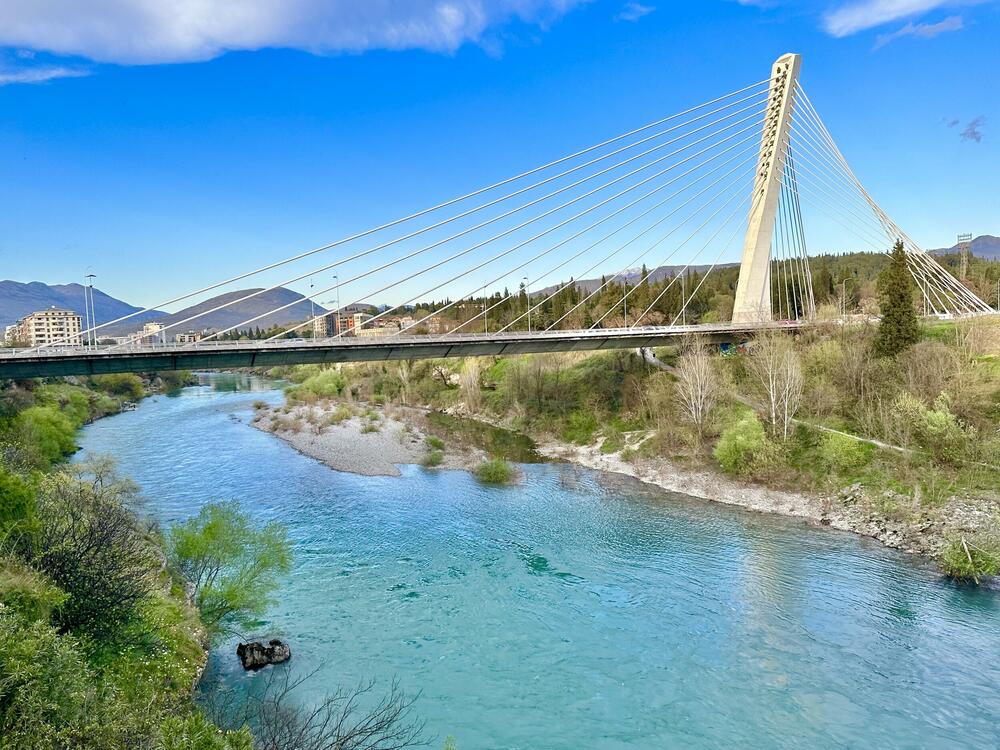
I would like to dip my feet in Morač, so I can assess whether it is as icy as the Neretva. But I reject that thought right away, maybe I'll come back to it if I find myself here in the hot Podgorica summer.
On the other shore
I head over the pedestrian Moscow Bridge to the other bank. I just think I've had enough of secular monumental heritage for today when I come across my favorite monument in Podgorica - erected in 1994 in honor of Vladimir Visocki, a Russian poet and singer-songwriter. Vladimir Visocki had only been dead for a few years when we listened to one and the same cassette in the XNUMXs - for younger people, an explanation is necessary that it was a sound carrier created after the gramophone record, and before the compact disc - in a Beran garden near Lim. The melodic melancholy of the Russian artist's lyrics remained in my memory. It is interesting to me that this work by the Russian sculptor Alexander Taratinov is the only monument to Vysotsky outside the borders of the former Soviet Union.
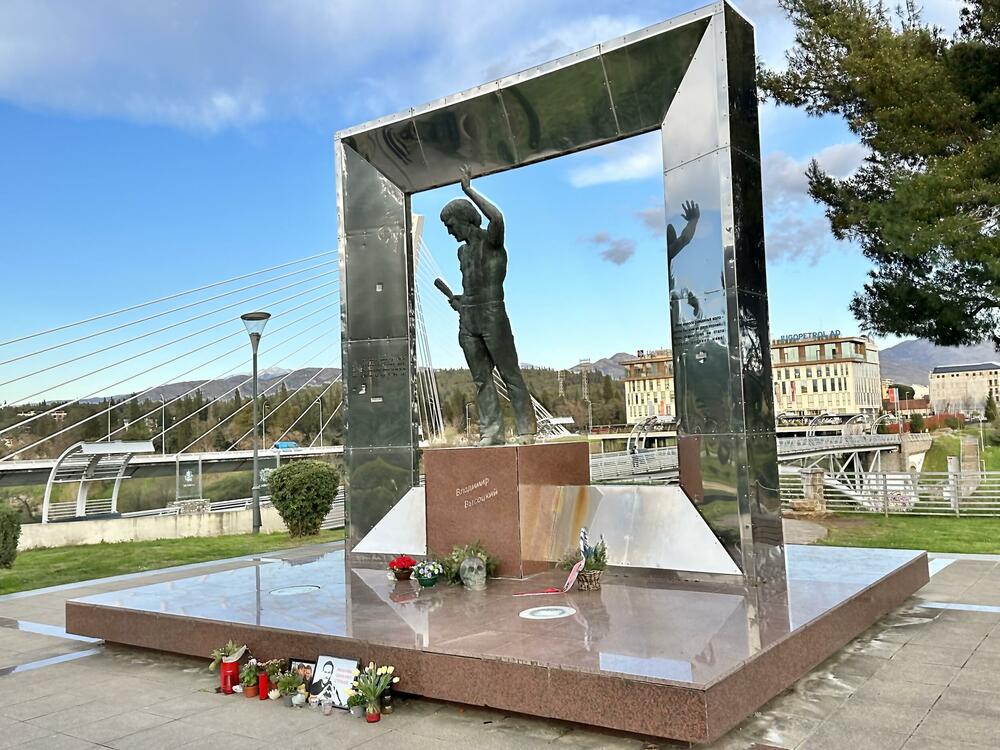
Behind Visocki, naked to the waist and barefoot, the Millennium Bridge can be seen, the same one that I compared to Morača's dress a moment ago, and which is easily recognizable from the plane. It has not even been two decades since it was built by a Slovenian company, and it has become one of the symbols of the city.
When I'm already on this coast, I'll walk to the Church of the Resurrection of Christ. I approach him on Vasa Raičković Street, a quiet, urban part of the city. The first twilight is falling.
The intention to build a congregational church of the Serbian Orthodox Church in Podgorica was thwarted by the Second World War. According to the design of the Belgrade architect Predrag Ristić, the construction of the temple began in 1993. It will last over two decades.

When I'm finally in front of the church, I see two bell towers on the front. Stone is dominant. The Church of St. Nicholas above Kuršumlija, which was built by a man born not far from this place, Stefan Nemanja, is one of the historical templates on which the architect created the design.
I enter the Temple and realize that next to the Temple on Vračar, this is the church building on which the least savings were made. The luxurious interior design tells believers two things - the heavens are bright and big, and man is insignificant and small.

What particularly pleased me was the image of a saint named Andrei Rublev. It was not the church that brought him close to me, but the great film artist Andrei Tarkovsky in his film named after the icon painter Rublev. Thus Tarkovsky again helped me to feel a closeness to one character in the Temple overpopulated with faces and meanings.
Eternal inspiration
At the round table tomorrow, it was shown that the love of the people who come from this land towards Montenegro is imbued with many other emotions. National Montenegrins are afraid of Serbian assimilation. And that includes those who live in Serbia, and those who are still the relative majority in Montenegro. Bosniaks who left Montenegro for the West with their bellies hungry for bread warn that there are no Montenegrin schools, and that their children have no place in either Serbian or Croatian supplementary education. One writer from the region, who was socialized in Ekavian and writes in Iekavian, permeated his presentation with the word "I'm not", which he never uses in his literary texts - thus wanting to repay his host. All together had inspired presentations about the homeland, in which some have never lived. And as always, when emotion intersects with Montenegro, the rhetoric can be full of superlatives.
I thought I would learn more about the ways in which Montenegro is seen in literature, and I learned a lot about the national passions and fears of Montenegrins.
I noticed that my Ekavica, which I surrendered to in my marriage and the country I live in, in Podgorica is inexorably suppressed by the Iekavian melody. Which is not Montenegrin but Bosnian. The taxi driver from the beginning of the text immediately read me by asking me where I grew up. It turned out that he was from a family from Herzegovina. He recognized a different Iekavian melody, closer to the one from his own childhood.
I hung out with writers Goran Samardžić, Faiz Softić and Dino Burdžević - continuing our conversations from Sarajevo, Belgrade, Frankfurt. I met interesting people such as the writer Nadija Rebronja or the sociologist Goran Kaluđerović, with whom I would gladly cross arguments, if there was more time. That gathering, mostly in the glazed garden of the Hilton, was actually the biggest gain of my stay in Podgorica.

Before heading to Berane, I'll drink a few local wines at the Mechanizam cafe with Goran Poleksić, a former intelligence officer, diplomat and painter whom I've known since my student days.
We apologized well, but I do not share his concern for Montenegrin statehood. It is a question of democratization and gathering of all citizens under the constitutional roof. Without sticking labels. All this takes time, at least two to three election cycles. And cultivating dialogue.
Goran is more critical of Podgorica, a city where, as he says, rock and roll was not accepted. But, naturally, he also likes her more. I prefer to keep a nice memory of Podgorica from my walk. I tell him that the previous, last night in Podgorica, I went to the river. To say goodbye to bridges. Bridges are to me what cathedrals are to others.
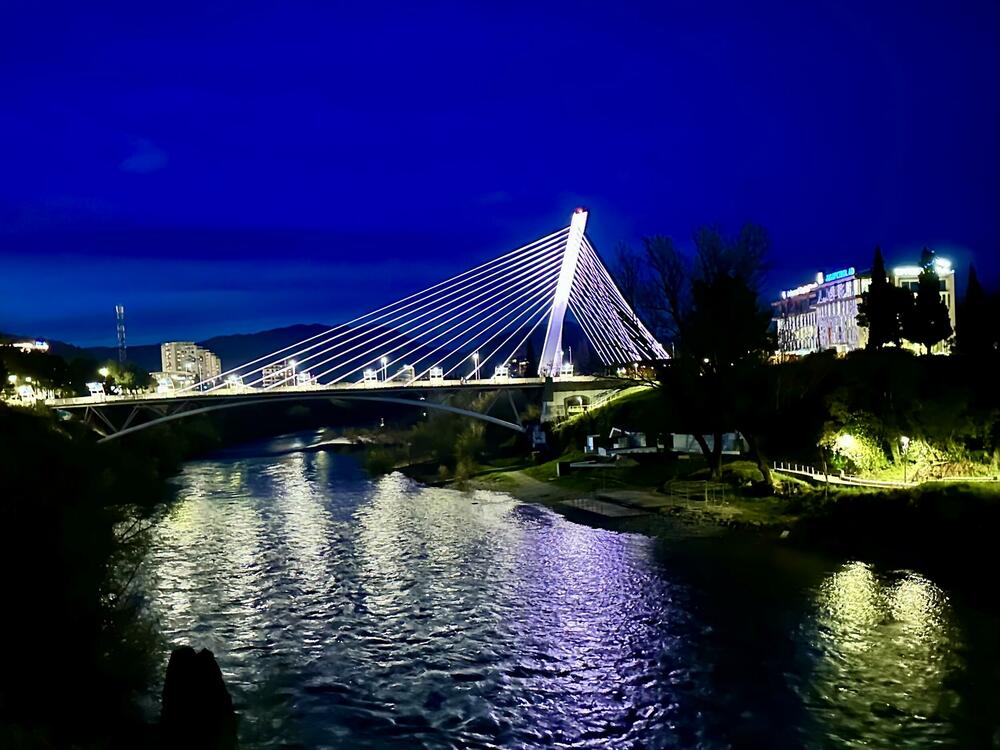
I am thinking about all this while reading the study "Unbreakable connection or geopolitical strategy - the influence of Serbia in Montenegro" on the bus. I would say that there is some truth in what I am reading. But there are simplifications and exaggerations that are the result of projected anxiety. I tried to understand her these days. With all that, but also with each other, they will have to deal with the people who live here.
I am thinking about this while the bus is ripping through the karst and tunnels towards the north of Montenegro. The north is from another story, the fears are different, yet so similar.
Bonus video:



